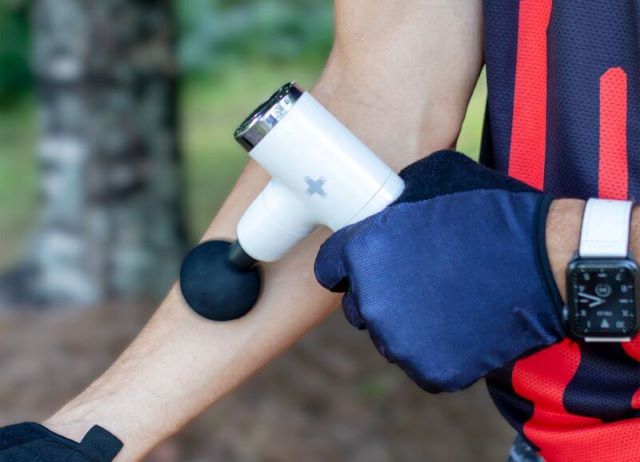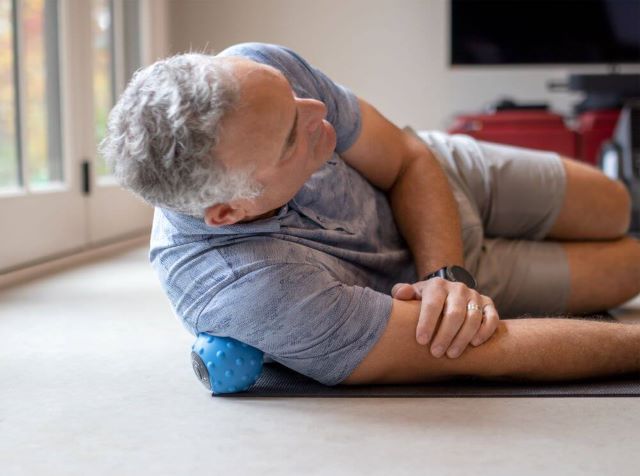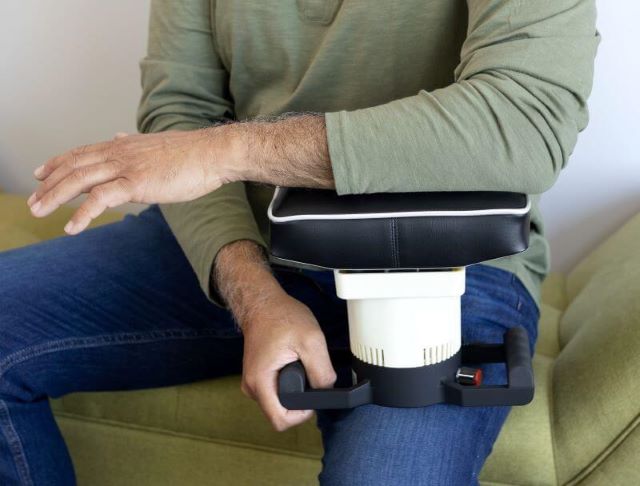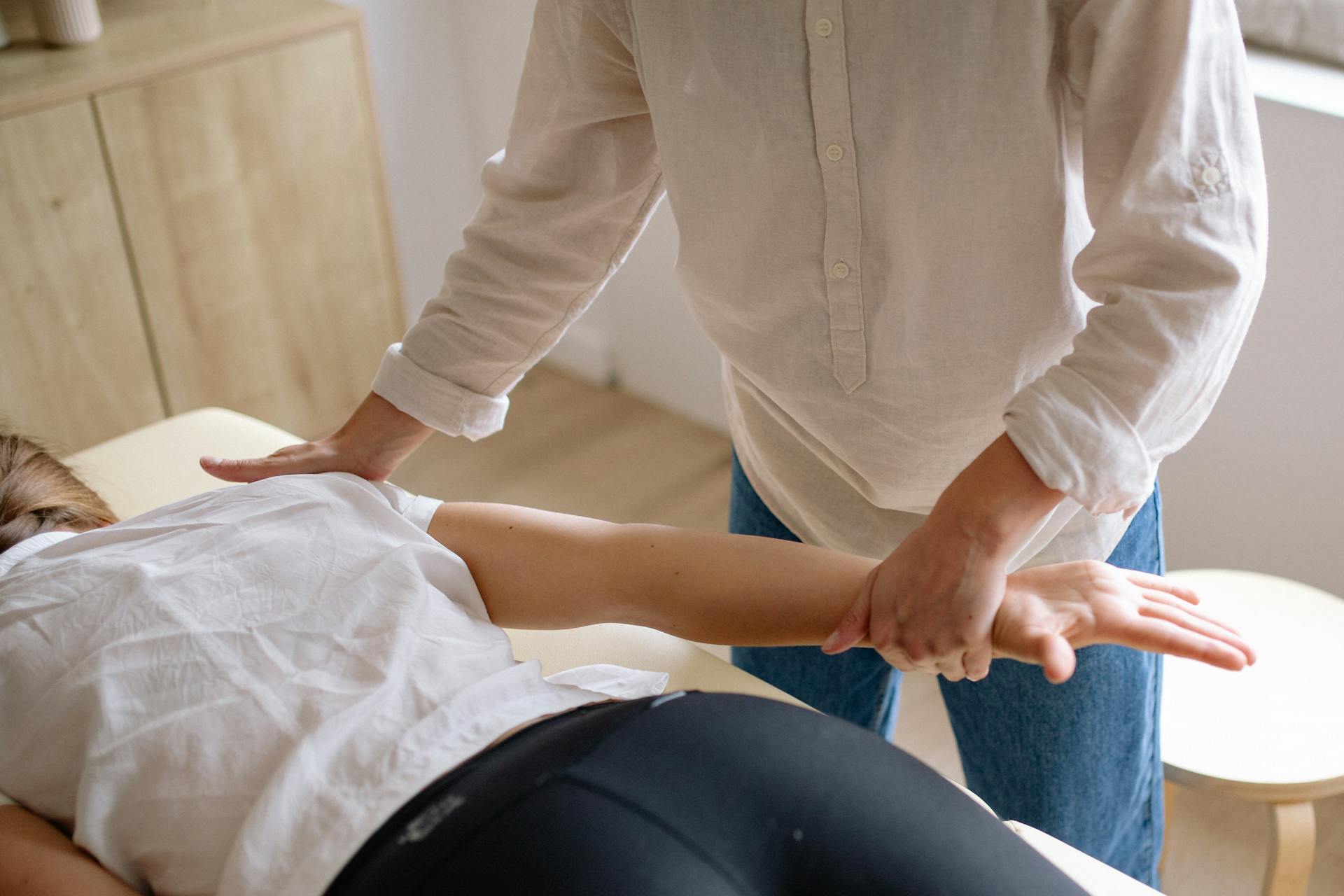Whether you’re an avid gym-goer, a hard laborer, or simply growing older, you might be all too familiar with pain in your arms and hands. These are some of the busiest parts of your body — which means they can be vulnerable to injury, aches, and stiffness.
The good news? Some simple TLC in the form of a hand and arm massage could offer relief. Below, learn seven easy techniques to try at home, along with a few tips to help you get started safely.
The Surprising Benefits of Hand and Arm Massage
An arm massage can bring a flood of health benefits to your joints, muscles, and other soft tissue. In specific, it can do the following:
Relieve Pain and Tension
If you’ve ever received a backrub after a long day, you might already know that massage can soothe pain. And while it’s a common remedy for backaches, it can also work wonders for your arms and hands.
The official position of the American Massage Therapy Association (AMTA) is that massage is useful for many types of discomfort. This includes general muscle pain, post-workout soreness, and pain from conditions such as carpal tunnel syndrome.
Support Healthy Blood Flow
A study by the University of Illinois at Chicago showed that massage improved peripheral vascular function after exercise. In addition, the Mayo Clinic lists increased circulation as one of massage’s potential benefits — which means a good massage may promote blood flow in your arms and hands.
It’s important to note that circulation as a whole starts with a healthy cardiovascular system. But a massage may help to bring a short-term boost to specific areas.
Improve Range of Motion
Over time, a sedentary lifestyle or an aging body can make staying flexible more difficult. Fortunately, a proper massage can help you loosen up your muscles, especially around stiff joints.
One 2017 review of seven studies showed that massage could increase shoulder range of motion (ROM), especially flexion and abduction. Beyond that, a 2015 study showed that massage boosted ROM in patients with knee arthritis.
Try These 7 Massage Techniques for Arms and Hands
Here are seven easy ways to massage your arms and hands at home. Some of these techniques will require equipment, and some won’t. This way, you have multiple options for giving yourself a high-quality massage — no matter what tools you have on hand.
1. Simple Focused Hand Massage

Because of the ever-growing time we spend typing and using technology, our hands often need more TLC than we think.
With that in mind, here’s how to do a simple hand massage. Try this a few times per week to keep hand and finger pain at bay.
- Using your thumb, massage the palm of your hand in light, circular motions for a few minutes. Take extra time to massage out any tight adhesions or knots.
- Slowly work your way to the lower palm area, using whichever level of pressure feels best to you.
- Now, begin to massage in fanning motions from the base of the palm up towards your fingers. (If your hands are dry, feel free to use a small amount of oil or lotion here.)
- Finish by lightly kneading each of your fingers to work out any tension in the tiny muscles.
- Repeat for 5 to 10 minutes on each hand.
2. Upper Arm Self-Massage
Here’s a quick 10-minute routine to help you alleviate tension in your biceps and triceps:
- Have a seat at a desk or kitchen table.
- Rest your arm on the surface, with your elbow slightly bent.
- With light pressure, start by gliding your hand across your upper arm muscles for a minute or two. This warms up and relaxes the muscles, preparing them for deeper work.
- Take a deep breath, and mindfully let go of any tension in your arm and shoulder. Then, knead and squeeze your bicep for a few minutes.
- Continue this process on the back of your upper arm.
- Repeat for up to 10 minutes.
3. Forearm Self-Massage
Your forearms work to grip, hold, type, swing, drive, etc. — and all of these activities can make them prone to aches and pains.
Here’s a quick self-massage routine for forearm pain relief:
- Have a seat wherever you feel most comfortable. For this massage, your arm can either be resting on your lap or a flat surface (like a desk).
- Start by using the palm of your hand to massage your forearm with deep, kneading motions. Do this for 1 to 2 minutes to warm up the muscles.
- Using your knuckles, massage the tissue on the inner forearm. Start below the elbow and glide down towards your wrist.
- For extra relief, you can flex your wrist up and down during this motion. This will add an element of stretching to your massage.
- To deepen the pressure, lean forward and use the edge of your opposite arm to massage the forearm in downward motions. Continue for 2 to 3 minutes.
- Use your hand to finish with a simple kneading technique on the posterior (or outer) muscles of your upper forearm.
4. Massage Gun for Sore Arms and Hands

The rapid bursts of a massage gun are great for your arms — and surprisingly, they can also work well for your hands.
Here’s a quick massage gun routine to try for sore arms and hands:
- Choose the massage gun attachment that best suits your needs. For some people, this might be a large, soft, round attachment. But you can also use a smaller head if you prefer.
- Turn your massage gun on to a low setting.
- Holding the gun at an angle, run it along your arm to warm up the tissue.
- Adjust the pressure to your liking, and continue to massage the upper and lower arm for another minute. Spend extra time on any knots you come across, but avoid the front of the elbow and wrist. (These areas can be sensitive to the pressure of a massage gun.)
- Slowly glide the massage gun along the palm of your hand at an angle. It may be beneficial to spend a few extra seconds on the thenar eminence, or the group of muscles at the base of your thumb. These muscles work nearly every time you use your hands and can hold a surprising amount of tension.
- Sweep the massage gun over your hand for a total of 30 to 60 seconds. Because there’s not much soft tissue at the back of your hand, it’s best to focus on the palm side instead.
5. Massage Ball for Self-Myofascial Release

If you don’t have any specific massage tools on hand, it’s no problem. As long as you’ve got a ball of some kind — like a tennis or lacrosse ball — you can easily massage your upper arms, lower arms, and even your hands.
Here’s how:
- To begin, find a sturdy wall to use as support.
- Extend your arm out to the side and place the ball between your bicep and the wall. Slowly move side-to-side to massage the muscle for 30 seconds to 1 minute.
- To work the back of your upper arm, you can place the ball on the floor and lay those muscles on top of it. From here, you can spend 30 seconds or so rolling. (This is pictured above.)
- Now, it’s time to work the forearm. You can either sit on the floor, use a coffee table, or sit at a desk for this exercise — whichever is more comfortable.
- Place the ball on the table, and rest the underside of your forearm on top of it.
- Roll for 30 seconds to massage your flexor muscles. (Check out this video for a demonstration.)
- Flip your arm so that your palm is facing up, and continue to roll. This will target your outer forearm muscles.
- Finish by rolling the palm of your hand on the ball. For deeper massage, you can use your body weight to lean into each rolling motion.
6. Foam Roller for Tired Biceps, Triceps, and Forearms
Foam rollers are popular for back and leg massage, but they can also work well as an arm massager. To start:
- Lay belly-first on a comfortable surface (such as a soft rug or yoga mat) with the roller in front of you.
- Rest your arm so that your triceps are on top of the roller.
- Slowly twist your arm from left to right. This simple motion will gently break up any tension in your upper arm muscles.
- Now, it’s time for the forearm. Sit slightly up and lean over the foam roller with your forearm resting on top of it.
- Slowly roll forward and backward, using the weight of your body to deepen the massage.
- Repeat these steps for 3 to 5 minutes.
7. Try An Oscillating Body Massager

Oscillating body massagers are effortless, user-friendly tools that can take the work out of self-massage. Here’s how to use one for arm pain relief:
- Start by turning the device to a low setting.
- Glide it along the entirety of your arm to warm up the muscles.
- After a minute or two, increase the pressure to your liking.
- Use your hands or ask a partner to apply the device to your upper arm muscles for 2 to 5 minutes. Feel free to spend extra time working on tender spots.
- To work on the forearm, you can simply place the device on your lap and rest your arm on top of it. Allow the massager to knead your muscles for another 2 to 5 minutes.
- Repeat for a total of 5 to 10 minutes, up to a few times per day.
What Kind of Pain Can Hand and Arm Massage Help With?
While massage can relieve general discomfort, it can also help with specific types of arm and hand pain. In fact, people with certain conditions — from arthritis to golfer’s elbow and tendonitis — often use massage as part of their daily routine.
Here are some types of pain that massage may help with.
Carpal Tunnel Syndrome
Carpal tunnel syndrome occurs when your median nerve becomes squeezed or compressed. It can result in numbness, tingling, and discomfort in the forearm and hand. Remarkably, research has shown that massage may relieve pain and boost function for people with this condition.
Soreness After the Gym
Massage can be game-changing if you enjoy lifting weights, playing sports, or training in any other way that involves your arms and hands. Of course, a massage feels incredible after a tough workout — but it also offers many other benefits for athletes.
For example, research has shown that a proper massage may reduce delayed onset muscle soreness (DOMS) and support performance after intense exercise.
Arthritis
Moderate-pressure massage may soothe arthritis-related pain and tension for certain people, according to the Arthritis Foundation. In specific, it may help with hand, wrist, and shoulder pain.
In a 2013 study, participants with rheumatoid arthritis in the upper limbs were randomly split into two groups: light-pressure massage, and moderate-pressure massage.
For four weeks, they received a weekly arm and shoulder massage from a massage therapist. They also spent some time each day self-massaging at home. The results showed that moderate-pressure massage was better for:
- Easing pain
- Increasing grip strength
- Boosting range of motion in the wrist, elbows, and shoulders
Best Types of Massage for Arms and Hands
If your arms and hands need more intensive TLC, you may wonder if it’s time to go beyond self-massage and see a masseuse. But what should you expect in a session, and which type of massage should you choose?
In truth, the best type of massage for arms and hands depends on your unique situation. At the beginning of a session, a massage therapist will spend a few minutes going over your health, concerns, and preferences to choose the best modality for you.
Here are some options they may recommend for your arms and hands.
Swedish Massage
Swedish massage is a soothing type of massage that uses long, light strokes to ease pain and relax the muscle tissue. This is the type to try if you’re interested in general relief and relaxation.
Sports Massage
Sports massage is helpful for athletic people, whether you’re a weightlifter, tennis player, or MMA fighter. This type of massage is meant to boost performance, recovery, and your overall training regimen.
It combines deep pressure and focused work to target specific muscles, tendons, and structures that are used in your activities. The techniques that your therapist uses might include:
- Vibration, rocking, or shaking
- Percussion therapy
- Effleurage and petrissage (Swedish-style strokes)
- Deep tissue
- Kneading
- Friction
- Stretching techniques to improve flexibility
Deep Tissue Massage
Many people receive deep tissue massages to work out deep tension and pain in active muscles, like those in the arms.
This modality uses slow, firm kneading and friction techniques to reach the deepest layers of your muscles. And it’s not only good for musculoskeletal issues, but it’s also a great way to relieve stress.
Safety Tips Before Starting Hand and Arm Massage
Here are some key tips to remember before trying any hand and arm massage techniques.
- Check with your doctor before starting, especially if you have any current medical conditions or injuries. Using past information about your health, your physician can help you determine how to go about massage safely.
- Avoid massaging any acute, inflamed injuries. When your body has a recent injury, the best thing to do is follow your doctor’s advice — whether that’s resting, icing, or another treatment. In this stage of injury, massage can actually worsen or aggravate things.
- It’s OK to work on areas of tenderness or discomfort, but be mindful of anything that downright hurts. For example, working out a tight knot in your bicep might make you wince a little. But it should subside as you work through the tension. If anything is significantly painful, it’s best to stop and try massage another day.
The Takeaway
Hand and arm massage is a simple, natural therapy that doesn’t require any special equipment to try. And while it won’t cure or heal underlying issues, it can still be an effective (and wonderfully relaxing) way to bring yourself some short-term relief.
To make therapeutic massage a core part of your routine, it can help to invest in home tools like the MedMassager Body Massager Plus. This device uses physician-trusted technology to mimic a masseuse’s hands, making it easier than ever to get spa-quality massage at home.
View MedMassager’s full range of home massage tools here, or learn more about their wellness-boosting uses today.



